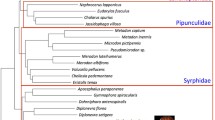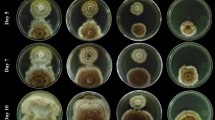Abstract
An ant-pathogenic neogregarine in Temnothorax affinis and T. parvulus (Hymenoptera: Formicidae) is described based on morphological and ultrastructural characteristics. The pathogen infects the hypodermis of the ants. The infection was mainly synchronous so that only gametocysts and oocysts could be observed simultaneously in the host body. Gametogamy resulted in the formation of two oocysts within a gametocyst. The lemon-shaped oocysts measured 11–13 μm in length and 8–10 μm in width. The surface of the oocysts is not smooth but contains many buds. A ring-shaped line containing rosary-arrayed buds line up in the equatorial plane of the oocyst. These specific characteristics were observed for the first time in neogregarine oocysts from ants. Polar plugs were recognizable clearly by light and electron microscopy. The oocyst wall was quite thick, measuring 775 to 1000 nm. Each oocyst contained eight sporozoites. The neogregarines in the two Temnothorax species show many similarities such as the size and shape of the oocysts, a relatively fragile gametocyst membrane, host affinity, and tissue preference. We identified these neogregarines as Mattesia cf. geminata, which is here recorded from natural ant populations in the Old World for the first time. All neogregarine pathogens infecting ants in nature so far have been recorded from the New World. We present the two ant species, Temnothorax affinis and T. parvulus, as new natural hosts for M. cf. geminata. Furthermore, the morphological and ultrastructural characteristics of the oocyst of M. cf. geminata are documented by scanning and transmission electron microscopy for the first time.



Similar content being viewed by others
Data availability
All of the data generated and analyzed during this study are included in this published manuscript.
References
Baki D, Tosun HŞ, Erler F (2021) Indigenous entomopathogenic fungi as potential biological control agents of rose sawfly, Arge rosae L. (Hymenoptera: Argidae). Turk J Zool 45:517–525. https://doi.org/10.3906/zoo-2105-15
Bolton B (2003) Synopsis and classification of Formicidae. Mem Am Entomol Inst 71:1–370
Buschinger A, Kleespies RG (1999) Host range and host specificity of ant-pathogenic gregarine parasite, Mattesia geminata (Neogregarinida: Lipotrophidae). Entomol Gen 24:93–104
Buschinger A, Kleespies RG, Schumann RD (1995) A gregarine parasite of Leptothorax ants from North America. Ins Soc 42:219–222
Crosland MWJ (1998) Effect of a gregarine parasite on the color of Myrmecia pilosula (Hymenoptera: Formicidae). Ann Entomol Soc Am 81:481–484. https://doi.org/10.1093/aesa/81.3.481
Jouvenaz DP, Anthony DW (1979) Mattesia geminata sp. n. (Neogregarinida: Ophrocystidae) a parasite of the tropical fire ant, Solenopsis geminata (Fabricus). J Protozool 26:354–356
Kiran K, Karaman C (2021) Ant fauna (Hymenoptera: Formicidae) of central Anatolian region of Turkey. Turk J Zool 45:161–196. https://doi.org/10.3906/zoo-2008-6
Kleespies RG, Huger AM, Buschinger A, Nähring S, Schumann RD (1997) Studies on the life history of a neogregarine parasite found in Leptothorax ants from North America. Biocontrol Sci Technol 7:117–129
Lange CE, Lord JC (2012) Chapter 10 – protistan entomopathogens. In: Vega FE, Kaya KK (eds) Insect pathology, 2nd edn. Academic Press, pp 367–394. https://doi.org/10.1016/B978-0-12-384984-7.00010-5
Levine ND (1988) The protozoan phylum Apicomplexa, vol 1 and 2. CRC Press, Boca Raton, p 357
Lord JC (2003) Mattesia oryzaephili (Neogregarinorida: Lipotrophidae), a pathogen of stored-grain insects: virulence, host range and comparison with Mattesia dispora. Biocontrol Sci Technol 13:589–598. https://doi.org/10.1080/0958315031000151800
Pereira RM, Williams DV, Becnel JJ, Oi HD (2002) Yellow-head disease caused by a newly discovered Mattesia sp. in populations of the red imported fire ant. Solenopsis Invicta J Invertebr Pathol 81:45–48
Perkins FO, Barta JR, Clopton R, Peirce MA, Upton SJ (2000) Phylum Apicomplexa. In: Lee JJ, Leedale GF, Bradbury P (eds) An illustrated guide to the protozoa, 2nd edn. Society of Protozoologists, Lawrence USA, pp 190–369
Radchenko A (2004) A review of the ant genera Leptothorax Mayr and Temnothorax Mayr (Hymenoptera, Formicidae) of the Eastern Palaearctic. Acta Zool Acad Sci Hung 50:109–137
Rasheed MT, Bodlah I, Magomedovıch YZ, Fareen AGE, Bodlah MA, Prebus M, Wachkoo AA (2020) Preliminary contributions toward a revision of the ant genus Temnothorax Mayr Hymenoptera: Formicidae from Pakistan. Turk J Zool 44:375–381. https://doi.org/10.3906/zoo-2003-54
Reynolds ES (1963) The use of lead citrate at high pH as an electron-opaque stain in electron microscopy. J Cell Biol 17:208–212
Spurr AR (1969) A low-viscosity epoxy resin embedding medium for electron microscopy. Clin Microbiol Res 3:197–218
Stukalyuk S, Radchenko Y, Netsvetov M, Gilev A (2020) Effect of mound size on intranest thermoregulation in the red wood ants Formica rufa and F. polyctena (Hymenoptera, Formicidae). Turk J Zool 44:266–280. https://doi.org/10.3906/zoo-1912-26
Stukalyuk S, Gilev A, Antonov I, Netsvetov M (2021) Size of nest complexes, the size of anthills, and infrastructure development in 4 species of red wood ants (Formica rufa, F. polyctena, F. aquilonia, F. lugubris) (Hymenoptera; Formicidae). Turk J Zool 45:464–478. https://doi.org/10.3906/zoo-2105-39
Undeen AH, Vávra J (1997) Research methods for entomopathogenic protozoa. In: Lacey L (ed) Manual of techniques in insect pathology. Academic Press, London, pp 117–151
Valles SM, Pereira RM (2003) Use of ribosomal DNA sequence data to characterize and detect a neogregarine pathogen of Solenopsis invicta (Hymenoptera: Formicidae). J Invertebr Pathol 84:114–118. https://doi.org/10.1016/j.jip.2003.09.001
Yaman M (2017) Distribution and occurrence of the neogregarine pathogen, Ophryocystis anatoliensis (Apicomplexa) in populations of Chrysomela populi L. (Coleoptera: Chrysomelidae). Acta Protozool 56:283–288
Yaman M, Radek R (2015) Mattesia weiseri sp. nov., a new neogregarine (Apicomplexa: Lipotrophidae) pathogen of the great spruce bark beetle, Dendroctonus micans (Coleoptera: Curculionidae, Scolytinae). Parasitol Res 114:2951–2958
Yaman M, Radek R (2017) Ophryocystis anatoliensis sp. nov., a new neogregarine pathogen of the chrysomelid beetle Chrysomela populi. Eur J Protistol 59:26–33
Acknowledgements
Temnothorax samples in this study were provided by one (K.K.) of authors from his collections. The author wants to mention that he received TUBITAK support while collecting these samples for another faunistic study.
Author information
Authors and Affiliations
Contributions
Mustafa Yaman conducted experiments, identified the neogregarine pathogen, and wrote the manuscript. Kadri Kıran provided ant samples. Renate Radek conducted experiments and improved the manuscript.
Corresponding author
Ethics declarations
Ethical approval
This is not applicable to the present manuscript.
Consent to participate
This is not applicable to the present manuscript.
Consent for publication
All authors reviewed and approved the final version of the manuscript.
Conflict of interest
The authors declare no competing interests.
Additional information
Handling Editor: Julia Walochnik
Publisher's note
Springer Nature remains neutral with regard to jurisdictional claims in published maps and institutional affiliations.
Rights and permissions
Springer Nature or its licensor (e.g. a society or other partner) holds exclusive rights to this article under a publishing agreement with the author(s) or other rightsholder(s); author self-archiving of the accepted manuscript version of this article is solely governed by the terms of such publishing agreement and applicable law.
About this article
Cite this article
Yaman, M., Kıran, K. & Radek, R. Mattesia cf. geminata, an ant-pathogenic neogregarine (Apicomplexa: Lipotrophidae) in two Temnothorax species (Hymenoptera: Formicidae). Parasitol Res 122, 1573–1579 (2023). https://doi.org/10.1007/s00436-023-07860-0
Received:
Accepted:
Published:
Issue Date:
DOI: https://doi.org/10.1007/s00436-023-07860-0




